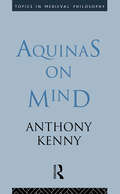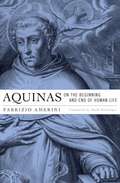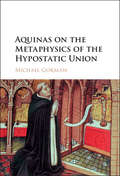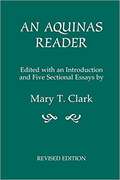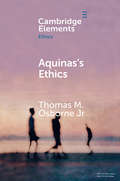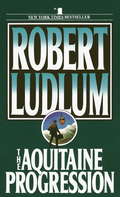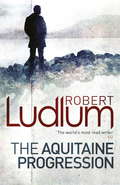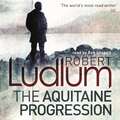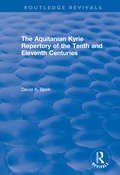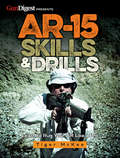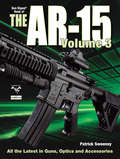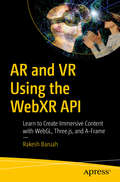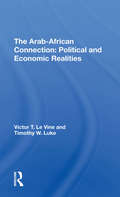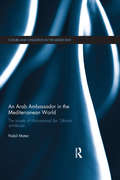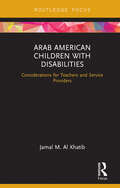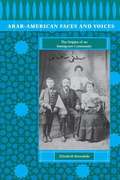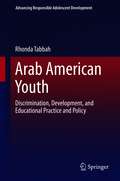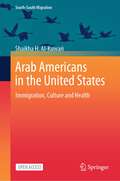- Table View
- List View
Aquinas on God: The 'Divine Science' of the Summa Theologiae (Ashgate Studies in the History of Philosophical Theology)
by Rudi Te VeldeAquinas on God presents an accessible exploration of Thomas Aquinas' conception of God. Focusing on the Summa theologiae - the work containing Aquinas' most systematic and complete exposition of the Christian doctrine of God - Rudi te Velde acquaints the reader with Aquinas' theological understanding of God and the metaphysical principles and propositions that underlie his project. Aquinas' conception of God is dealt with not as an isolated metaphysical doctrine, but from the perspective of his broad theological view which underlies the scheme of the Summa. Readers interested in Aquinas, historical theology, metaphysics and metaphysical discourse on God in the Christian tradition will find this new contribution to the studies of Aquinas invaluable.
Aquinas on Human Self-Knowledge
by Therese Scarpelli CorySelf-knowledge is commonly thought to have become a topic of serious philosophical inquiry during the early modern period. Already in the thirteenth century, however, the medieval thinker Thomas Aquinas developed a sophisticated theory of self-knowledge, which Therese Scarpelli Cory presents as a project of reconciling the conflicting phenomena of self-opacity and privileged self-access. Situating Aquinas's theory within the mid-thirteenth-century debate and his own maturing thought on human nature, Cory investigates the kinds of self-knowledge that Aquinas describes and the questions they raise. She shows that to a degree remarkable in a medieval thinker, self-knowledge turns out to be central to Aquinas's account of cognition and personhood, and that his theory provides tools for considering intentionality, reflexivity and selfhood. Her engaging account of this neglected aspect of medieval philosophy will interest readers studying Aquinas and the history of medieval philosophy more generally.
Aquinas on Mind (Topics in Medieval Philosophy)
by Anthony Kenny Sir Anthony KennyThis book shows how the mature writings of Thomas Aquinas though written in the thirteenth century have much to offer the human mind and the relationship between intellect and will, body and soul.
Aquinas on the Beginning and End of Human Life
by Fabrizio AmeriniIn contemporary discussions of abortion, both sides argue well-worn positions, particularly concerning the question, When does human life begin? Though often invoked by the Catholic Church for support, Thomas Aquinas in fact held that human life begins after conception, not at the moment of union. But his overall thinking on questions of how humans come into being, and cease to be, is more subtle than either side in this polarized debate imagines. Fabrizio Amerini--an internationally renowned scholar of medieval philosophy--does justice to Aquinas's views on these controversial issues. Some pro-life proponents hold that Aquinas's position is simply due to faulty biological knowledge, and if he knew what we know today about embryology, he would agree that human life begins at conception. Others argue that nothing Aquinas could learn from modern biology would have changed his mind. Amerini follows the twists and turns of Aquinas's thinking to reach a nuanced and detailed solution in the final chapters that will unsettle familiar assumptions and arguments. Systematically examining all the pertinent texts and placing each in historical context, Amerini provides an accurate reconstruction of Aquinas's account of the beginning and end of human life and assesses its bioethical implications for today. This major contribution is available to an English-speaking audience through translation by Mark Henninger, himself a noted scholar of medieval philosophy.
Aquinas on the Metaphysics of the Hypostatic Union
by Michael GormanThe hypostatic union of Christ, namely his being simultaneously human and divine, is one of the founding doctrines of Christian theology. In this book Michael Gorman presents the first full-length treatment of Aquinas's metaphysics of the hypostatic union. After setting out the historical and theological background, he examines Aquinas's metaphysical presuppositions, explains the basic elements of his account of the hypostatic union, and then enters into detailed discussions of four areas where it is more difficult to get a clear understanding of Aquinas's views, arguing that in some cases we must be content with speculative reconstructions that are true to the spirit of Aquinas's thought. His study pays close attention to the Latin texts and their chronology, and engages with a wide range of secondary literature. It will be of great interest to theologians as well as to scholars of metaphysics and medieval thought.
Aquinas, Original Sin, and the Challenge of Evolution
by Daniel W. HouckIs original sin compatible with evolution? Many today believe the answer is 'No'. Engaging Aquinas's revolutionary account of the doctrine, Daniel W. Houck argues that there is not necessarily a conflict between this Christian teaching and mainstream biology. He draws on neglected texts outside the Summa Theologiae to show that Aquinas focused on humanity's loss of friendship with God - not the corruption of nature (or personal guilt). Aquinas's account is theologically attractive in its own right. Houck proposes, moreover, a new Thomist view of original sin that is consonant with evolution. This account is developed in dialogue with biblical scholarship on Jewish hamartiology and salient modern thinkers (including Kant, Schleiermacher, Barth, and Schoonenberg), and it is systematically connected to debates over nature, grace, the desire for God, and justification. In addition, the book canvasses a number of neglected premodern approaches to original sin, including those of Anselm, Abelard, and Lombard.
An Aquinas Reader: Selections from the Writings of Thomas Aquinas
by Mary T. ClarkAvailable in a new digital edition with reflowable text suitable for e-readersThis new edition of An Aquinas Reader contains in one closely knit volume representative selections that reflect every aspect of Aquinas’s philosophy. Divided into three section – Reality, God, and Man – this anthology offers an unrivaled perspective of the full scope and rich variety of Aquinas’s thought. It provides the general reader with an overall survey of one of the most outstanding thinks or all time and reveals the major influence he has had on many of the world’s greatest thinkers. This revised third edition of Clark’s perennial still has all of the exceptional qualities that made An Aquinas Reader a classic, but contains a new introduction, improved format, and an updated bibliography.
Aquinas's Ethics (Elements in Ethics)
by Thomas M. Osborne JrThis Element provides an account of Thomas Aquinas's moral philosophy that emphasizes the intrinsic connection between happiness and the human good, human virtue, and the precepts of practical reason. Human beings by nature have an end to which they are directed and concerning which they do not deliberate, namely happiness. Humans achieve this end by performing good human acts, which are produced by the intellect and the will, and perfected by the relevant virtues. These virtuous acts require that the agent grasps the relevant moral principles and uses them in particular cases.
Aquinas’s Philosophy of Religion
by Paul O’GradyThis is an exploration and analysis of Aquinas's contribution to the philosophy of religion. It examines Aquinas's contexts, his views on philosophy and theology, as well as faith and reason. His arguments for God's existence, responses to objections against God's existence and his characterization of the nature of God are examined.
Aquinas's Summa Theologiae: A Critical Guide (Cambridge Critical Guides)
by Jeffrey HauseAlone among Thomas Aquinas's works, the Summa Theologiae contains well-developed and integrated discussions of metaphysics, ethics, law, human action, and the divine nature. The essays in this volume, by scholars representing varied approaches to the study of Aquinas, offer thorough, cutting-edge expositions and analyses of these topics and show how they relate to Aquinas's larger system of thought. The volume also examines the reception of the Summa Theologiae from the thirteenth century to the present day, showing how scholars have understood and misunderstood this key text, and how, even after seven centuries of interpretation, we still have much to learn from it. Detailed and accessible, this book will be highly important for scholars and students of medieval philosophy and theology.
The Aquitaine Progression: A Novel (Panther Bks.)
by Robert LudlumIt begins in Geneva. There American lawyer Joel Converse meets a man he hasn't seen in twenty years, a covert operative who dies violently at his feet, whispering words that hand Converse a staggering legacy of death: "THE GENERALS...THEY'RE BACK...AQUITAINE!" Suddenly Converse is running for his life, alone with the world's most shattering secret. Pursued by anonymous executioners to the dark corners of Europe, he is forced to play a game of survival by blood rules he thought he'd long left behind. One by one, he traces each thread of a deadly progression to the hear of every major government--a network of coordinated global violence that no one believes possible. No one but Converse and the woman he once loved and lost. The only two people on earth who can wrest the world from the iron grasp of Aquitaine. BONUS: This edition includes an excerpt from Robert Ludlum's The Bourne Identity.
The Aquitaine Progression
by Robert LudlumA shattering secret...and a chilling game of survival...A terrifying international thriller from the No. 1 bestselling author.It begins in Geneva. There, American lawyer Joel Converse meets a man he hasn't seen in twenty years, a covert operative who dies violently at his feet, whispering words that hand Converse a staggering legacy of death: 'The generals...they're back...Aquitaine!'Suddenly Converse is running for his life, alone with the world's most shattering secret. Pursued by anonymous executioners to the darkest corners of Europe, he is forced to play a game of survival by blood rules he thought he'd long left behind. And only Converse, and the woman he once loved and lost, can wrest the world from the iron grasp of Aquitaine...
The Aquitaine Progression
by Robert LudlumIt begins in Geneva. There American lawyer Joel Converse meets a man he hasn't seen in twenty years, a covert operative who dies violently at his feet, whispering words that hand Converse a staggering legacy of death: 'The generals ... they're back ... Aquitaine!'Suddenly Converse is running for his life, alone with the world's most shattering secret. Pursued by anonymous executioners to the darkest corners of Europe, he is forced to play a game of survival by blood-rules he thought he'd long left behind. And only Converse, and the woman he once loved and lost, can wrest the world from the iron grasp of Aquitaine...Read by Rob Shapiro. Rob Shapiro is a voice actor, narrator, musician and writer. In his spare time, he is working on his first book.(p) 2012 Penguin Random House LLC
The Aquitanian Kyrie Repertory of the Tenth and Eleventh Centuries
by Richard Crocker David BjorkThis book was published in 2003. One of the most important but least studied of medieval chant repertories is that of the Kyrie. With their Latin texts, Kyrie melodies represented musical ambitions manifested alongside of and subsequent to Gregorian chant - ambitions which achieved stylistic and formal distinction. This study illuminates those features of the early Kyrie that give it its distinctive character and set it apart not only from Gregorian chant but also from other types of medieval chant. The repertory focused on in this book is a group of 22 West Frankish sources which are believed to have originated in several Aquitanian locations. The tradition represented by these manuscripts and their repertory of Kyrie melodies can be followed across a century and a half, from 950 to 1100. The Aquitanian manuscript tradition is significant because these sources represent by far the largest group of closely inter-related musical sources from the period, and the musical notation gives reliable indication of pitch up to a century earlier than other manuscripts of the time. By incorporating both a detailed musical study and transcriptions of these sources this book should be of interest to those who are concerned with the construction of these pieces as well as to those who wish to appreciate them, or even perform them.
The AR-15 Volume 3
by Patrick SweeneyThe AR-15 has become America's favorite rifle-and no one knows it better than Patrick Sweeney. Now, in Volume 3 of his best-selling series on the AR, Sweeney unlocks the mysteries behind the piston AR. From factory-stock rifles to do-it-yourself conversions, if there's anything you want to know about the latest generation of the AR-15s, you'll find it in Gun Digest ® Book of The AR-15, Volume 3. It's All Here! Piston designs Conversions from direct impingement to piston operation New manufacturers: H&K, Sun Devil, CMMG, among others Magazines and other accessories And much, much more! Whether you're buying your first AR or building one from the ground up, there's no better reference than Sweeney's AR series from Gun Digest ® Books. And now, with Gun Digest ® Book of The AR-15, Volume 3, you too, will be an expert on the most popular rifle in America!
AR and VR Using the WebXR API: Learn to Create Immersive Content with WebGL, Three.js, and A-Frame
by Rakesh BaruahGain an in-depth knowledge in immersive web development to create augmented reality (AR) and virtual reality (VR) applications inside web browsers using WebXR API, WebGL, Three.js, and A-Frame. This project-based book will provide the practice and portfolio content to make the most of what the futures of spatial computing and immersive technology have to offer.Beginning with technical analysis of how web browsers function, the book covers programming languages such as WebGL, JavaScript, and HTML, with an eye on a complete understanding of the WebXR lifecycle. You'll then explore how contemporary web browsers work at the code level and see how to set up a local development server and use it with the Visual Studio Code IDE to create 3D animation in the WebGL programming language. With a familiarity of the web-rendering pipeline in place, you’ll venture on to WebGL abstractions such as the Three.js JavaScript library and Mozilla’s A-Frame XR Framework, which use WebXR to create high-end visual effects. In the final projects of the book, you’ll create an augmented reality web session for an Android phone device, and create a VR scene in A-Frame (built on Three.js) to demo essential components of the WebXR API pertaining to user positioning and interaction.Game engines have become common-place for the creation of mixed reality content. However, developers not interested in learning entirely new workflows may be better suited to work within a medium almost universally open to all—the web; AR and VR Using the WebXR API will show you the way.What You'll LearnMaster the creation of virtual reality and augmented reality features for web pagePrepare to work as an immersive web developer with a portfolio of projects in sought-after technologiesReview the fundamentals of writing shaders in WebGLExperience the unity between client, server, and cloud architecture as it applies to location-based ARWho This Book Is ForAspiring immersive web developers and developers already familiar with the fundamentals of web development who want to further explore topics such as spatial computing, computer vision, spatial anchors, and cloud-computing for multi-user social experiences.
The Arab-african Connection: Political And Economic Realities
by Victor T Le Vine Timothy W LukeBetween June 1967 and the end of 1973, most independent Black African states abandoned their neutral position in the Middle East conflict, cut their ties with Israel, and gave full support to the political aims of the Arab states. Since the beginning of 1974, however, and despite attempts by the Arabs to shield their new allies from the adverse effects of the 1973-74 world oil and economic crises, the alliance has begun to fragment as the African states become transformed from partners to clients and dependents of the Arabs. This study examines the roots of the African conversion, the nature of the evolving relationship between the African and Arab states, and the reasons—economic and political—for the transformation of the alliance. Basic to that transformation, the authors argue, is a fundamental change in the international status and power of the Arab states, a change that has led them to cast their lot with the industrialized "First World" rather than with the poorer, less developed countries.
An Arab Ambassador in the Mediterranean World: The Travels of Muhammad ibn ‘Uthmān al-Miknāsī, 1779-1788 (Culture and Civilization in the Middle East)
by Nabil MatarThis book provides translated selections from the writings of Muhammad Ibn Othman al-Miknasi (d. 1799). The only writings by an Arab-Muslim in the pre-modern period that present a comparative perspective, his travelogues provide unique insight with in to Christendom and Islam. Translating excerpts from his three travelogues, this book tells the story of al-Miknasi’s travels from 1779-1788. As an ambassador, al-Miknasi was privy to court life, government offices and religious buildings, and he provides detailed accounts of cities, people, customs, ransom negotiations, historical events and political institutions. Including descriptions of Europeans, Arabs, Turks, Christians (both European and Eastern), Muslims, Jews, and (American) Indians in the last quarter of the eighteenth century, An Arab Ambassador in the Mediterranean World explores how the most travelled Muslim writer of the pre-modern period saw the world: from Spain to Arabia and from Morocco to Turkey, with second-hand information about the New World. Supplemented with extensive notes detailing the historic and political relevance of the translations, this book is of interest to researchers and scholars of Mediterranean History, Ottoman Studies and Muslim-Christian relations.
Arab America: Gender, Cultural Politics, and Activism (Nation of Nations #13)
by Nadine NaberArab Americans are one of the most misunderstood segments of the U.S. population, especially after the events of 9/11. In Arab America, Nadine Naber tells the stories of second generation Arab American young adults living in the San Francisco Bay Area, most of whom are political activists engaged in two culturalist movements that draw on the conditions of diaspora, a Muslim global justice and a Leftist Arab movement.Writing from a transnational feminist perspective, Naber reveals the complex and at times contradictory cultural and political processes through which Arabness is forged in the contemporary United States, and explores the apparently intra-communal cultural concepts of religion, family, gender, and sexuality as the battleground on which Arab American young adults and the looming world of America all wrangle. As this struggle continues, these young adults reject Orientalist thought, producing counter-narratives that open up new possibilities for transcending the limitations of Orientalist, imperialist, and conventional nationalist articulations of self, possibilities that ground concepts of religion, family, gender, and sexuality in some of the most urgent issues of our times: immigration politics, racial justice struggles, and U.S. militarism and war.For more, check out the author-run Facebook page for Arab America.
Arab American Aesthetics: Literature, Material Culture, Film, and Theatre (Routledge Studies on Middle Eastern Diasporas)
by Therí A. PickensArab American Aesthetics enlists a wide range of voices to explore, if not tentatively define, what could constitute Arab American aesthetics in literature, material culture, film, and theatre. This book seeks to unsettle current conversations within Arab American Studies that neglect aesthetics as a set of choices and constraints. Rather than divorce aesthetics from politics, the book sutures the two more closely together by challenging the causal relationship so often attributed to them. The conversations include formal choices, but also extend to the broad idea of what makes a work distinctly Arab American. That is, what about its beauty, ugliness, sublimity, or humor is explicitly tied to it as part of a tradition of Arab American arts? The book opens up the ways that we discuss Arab American literary and fine arts, so that we understand how Arab American identity and experience begets Arab American artistic enterprise. Split into three sections, the first offers a set of theoretical propositions for understanding aesthetics that traverse Arab American cultural production. The second section focuses on material culture as a way to think through the creation of objects as an aesthetic enterprise. The final section looks at narratives in theatre and how the impact of such a medium has the potential to recreate in both senses of the word: play and invention. By shifting the conversation from identity politics to the relationship between politics and aesthetics, this book provides an important contribution to Arab American studies. It will also appeal to students and scholars of ethnic studies, museum studies, and cultural studies.
Arab American Children with Disabilities: Considerations for Teachers and Service Providers
by Jamal M. Al KhatibDespite a proliferation of special education literature on racial minorities over the past three decades, research and writing on Arab American children with disabilities remain remarkably sparse. This book fills that gap by promoting culturally appropriate services for Arab American children with disabilities. Special education and service providers in the U.S.—including school psychologists, rehabilitation counselors, and social workers—are increasingly likely to work with Arab Americans with disabilities. By focusing on this marginalized minority population, Al Khatib provides much-needed context and direction for service providers and researchers working with the Arab American community. Offering an overview of special education and the rights guaranteed under the Individuals with Disabilities Education Act (IDEA), this book also helps Arab American families understand the special education process and advocate for their children.
Arab-American Faces and Voices: The Origins of an Immigrant Community
by Elizabeth BoosahdaIn this book, Elizabeth Boosahda, a third-generation Arab American, draws on over two hundred personal interviews, as well as photographs and historical documents that are contemporaneous with the first generation of Arab Americans (Syrians, Lebanese, Palestinians), both Christians and Muslims, who immigrated to the Americas between 1880 and 1915, and their descendants.Boosahda focuses on the Arab-American community in Worcester, Massachusetts, a major northeastern center for Arab immigration, and Worcester's links to and similarities with Arab-American communities throughout North and South America.
Arab American Youth: Discrimination, Development, and Educational Practice and Policy (Advancing Responsible Adolescent Development)
by Rhonda TabbahThis book examines the implications of discrimination in Arab American youth with a focus on K-12 school systems. It begins with an introduction to Arab American youth and their experiences in the education system. The book follows with an overview regarding historical contributions of discrimination and the history of discrimination against Arabs in America, including the education system. It then presents relevant theoretical perspectives regarding discrimination and developmental processes. The book examines research specific to Arab American youth, identifies research limitations, and provides strategies on how to strengthen methodological approaches to better inform research, practice, and policy. It concludes by offering strategies for improving educational practice and policy and recommendations for interventions designed to enhance developmental health of Arab American youth in schools.Key areas of coverage include:Arab American youth, development, and discrimination in America.Discrimination in the K-12 educational system.Self-concept, ethnic identity, well-being and discrimination among Arab American youth.Arab American Youth is an essential resource for practitioners, researchers, educators, and related professionals as well as graduate students in school psychology, educational psychology, education, and related disciplines.______________________________________________________________________Dr. Tabbah has written a book that is well overdue … she provides a blueprint for moving forward in education as well as in policy development that can be transformative for Arab-American youth. Antoinette Miranda, Professor of School Psychology, The Ohio State University This book is a valuable contribution given the nascent literature on the experiences of Arab youth and the significant impact of discrimination on their schooling. Desiree Vega, Associate Professor of School Psychology, University of Arizona
Arab Americans in the United States: Immigration, Culture and Health (International Perspectives on Migration)
by Shaikha H. Al-KuwariThis open access book provides a unique perspective on the relationship between immigration, culture, and health. It presents a cross-cultural perspective between culture and illness. It touches upon identity struggles, the notion of not feeling “safe, understood, accepted,” and its relation to Arab American health. The book provides a comprehensive review of the history of Muslims in America and discusses better healthcare services for chronic illness—diabetes. It provides an ethnographic framework for building cultural belief models of illness, which helps study any illness among any population. It is a must-read for everyone interested in understanding the relationship among culture, health, and immigration, as well as the importance of building cultural belief models of illness and their possible impact on providing better healthcare services. The book is of interest to scholars, caregivers, and those living with diabetes.


